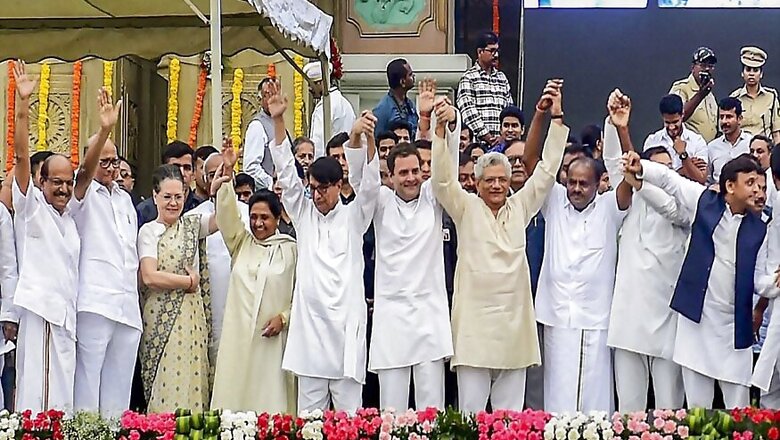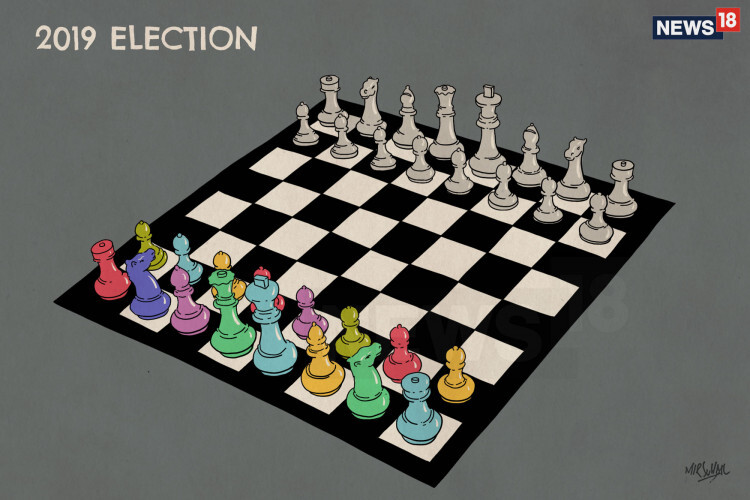
views
New Delhi: The photo-op at HD Kumaraswamy’s swearing in ceremony in Bengaluru was just the beginning of the bonhomie among the titans of India’s opposition parties. It has now translated into an actual battle plan.
According to sources, out of the 543 Lok Sabha seats that will be up for grabs in 2019, the opposition parties have identified 400 where it wants to pin the BJP down in a one-on-one contest.
NCP leader Majid Memon confirmed the plan. He told News18 that this was in the works much before the Karnataka results. “Almost all non-BJP parties - from Kashmir to Tamil Nadu, from Abdullah to Stalin - have volunteered to come together burying their internal differences,” Memon said.
A Congress source privy to the discussion said that the plan has been formulated because it is clear that the concept of ‘one size fits all’ won’t work and that it needs to be state specific.
The biggest success story for this plan so far has been the coming together of the Mayawati’s BSP and Akhilesh Yadav’s SP. In the three Lok Sabha bypolls in Uttar Pradesh since March, the parties backed a joint candidate and emerged victorious in all three.
A Samajwadi Party leader explained how they are planning to have alliances in some places, but not in others. “Sometimes an alliance is beneficial, like in Kairana, and sometimes, it is harmful, like in Phulpur,” he said.
The SP leader said it was a blessing in disguise that the Congress did not join the alliance in eastern Uttar Pradesh because of its image as a ‘Brahmin party’. He said it was not helpful that the Congress’ Phulpur candidate, Manish Mishra, was a Brahmin as well.
In the bypolls, the Congress party was spurned by the SP and had to go it alone. While the SP backed by the BSP managed to defeat the BJP easily in Phulpur, giving proof that a united opposition can work, the Congress was left in a distant third place, further eroding its bargaining power in the state.

United colours of the opposition versus the BJP. (Illustration by Mir Suhail/News18)
After the bypoll result, it was West Bengal chief minister Mamata Banerjee who first came up with the idea of implementing the one-on-one fight concept across the country.
In March this year, soon after the results, Banerjee had travelled to Delhi. She proposed a template on how the opposition should unite to take on BJP in 2019. The TMC leader had made it clear that the Congress should back regional parties in states where they are strong.
"The political party which is strong in a particular state should be allowed to work there. If in Uttar Pradesh, the Mayawati-Akhilesh Yadav combine is strong, they should work together... We should help them," Mamata had said after her series of meetings with different party leaders in Parliament.
A senior Congress leader, who is close to both Sonia and Rahul Gandhi, admitted that the party will have to take the back seat in certain states.
“Mamata Banerjee will not yield her fortress. Tejashwi Yadav is rising in Bihar. Why will they agree to be junior players?” he asked.
Banerjee’s support could make or break the alliance. With 34 seats in the Lok Sabha, the All India Trinamool Congress has just 11 seats less than the Congress in the Lok Sabha.
While the Congress leaders believe that the Grand Old Party would be the pivot for the 2019 Mahagathbandhan, they are also aware that their negotiating power will depend on the results of the upcoming assembly elections in Rajasthan, Madhya Pradesh and Chattisgarh.
“In all these three states, it is a straight fight between BJP and Congress. If we are able to win here it will increase our negotiating power vis-à-vis regional satraps. The Mahagathbandhan will be finalized by December, after the assembly polls,” a Congress source said.
The one thing that is keeping the opposition together is that ‘everyone wants the BJP out’.
At CPI(M)’s party congress in Hyderabad in April this year, the party agreed to adopt its general secretary Sitaram Yechury’s line of defeating the BJP as the primary objective and be open to the idea of allying with the Congress.
Sources within the Congress party said Yechury has also taken the lead on the plan for one-on-one contests, as he did in Karnataka, where he played a key role in bringing the Congress and JD(S) together.
However, Memon believes Sharad Pawar is the ‘tallest leader’ in the country and has the capability to bring everybody together. “Nobody can say ‘no’ to him. Pawar is a mentor who can play the role of cementing factor for everybody,” Memon said.
Former JD(U) leader Sharad Yadav had also organized the ‘Sanjhi Virasat Bachao’ Conclave in August 2017 at Delhi’s Constitution Club. The event saw several parties come together on one platform. “Ek ek suba aata jayega, baat karte jayenge (We will keep discussing state by state),” Yadav told News18.
Congress sources also said that senior leaders including Ghulam Nabi Azad, Ahmed Patel and Kamalnath are in talks with regional parties. The meeting between RJD leader Tejashwi Yadav and Rahul Gandhi had also assumed significance for the same reason.
Sources also revealed that JD(U), which had pulled out of the grand alliance with RJD and Congress in Bihar, has also sent feelers to the Congress. Although emphasizing on the alliance with NDA, JD(U) leader Pawan Verma said that the BJP must learn to treat its allies with respect and equality.
But RJD leaders have vehemently denied the possibility of Nitish Kumar and Lalu Prasad Yadav sharing a stage before the 2019 elections. “The biggest issue is managing egos. Will Mamata and Left come together? Will Lalu and Nitish?” a Congress leader asked.
It won’t be smooth sailing for the Mahagathbandhan. An SP leader said that the biggest challenge would be to ensure transparency in ticket distribution. “BSP has been accused of selling tickets in the past. Will Mayawati agree to a transparent system of ticket distribution for all 80 seats in UP?” he asked.
The Aam Aadmi Party is also in the fray. A senior AAP leader said, “Around the Karnataka elections, a senior Congress leader approached Arvind Kejriwal and said they were willing to support AAP on six Lok Sabha seats of Delhi but wanted one for themselves. They also want a similar arrangement in Punjab and Haryana. When Arvind heard this, he didn’t take it seriously. But the Congress leader pointed to the success of the SP-BSP alliance. We have no love for the Congress, but everyone is beginning to see that BJP is the biggest threat to this country.”
NCP leader Memon said that satraps of various states have been spoken to and the one point agenda is to defeat the BJP in the next Lok Sabha polls. The NCP leader added that the parties have decided to come together to protect the nation from being ‘destroyed’. “We won’t mind sacrificing our own seats for greater national interest,” he said.

















Comments
0 comment